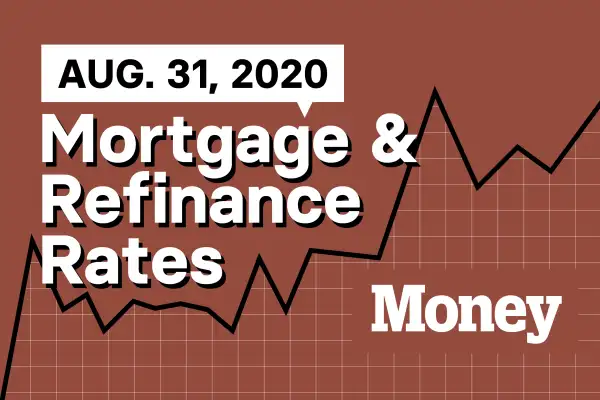Here Are Today's Best Mortgage & Refinance Rates for August 31, 2020

Borrowers with 700 credit scores were quoted an average rate of 3.455% to secure a 30-year fixed-rate purchase mortgage on Friday, according to Money's survey of over 8,000 lenders across the country. At this credit score, roughly the national average, the average rate for a 30-year refinance was 4.339%. Our rates include discount points and are for borrowers putting 20% down.
| 30-year fixed-rate purchase mortgage |
| 3.455% |
| Rates of August 28, 2020 |
Borrowers in Illinois were quoted the lowest mortgage rates on Friday—at a rate of 3.282%. Those in New Mexico saw the highest average at 3.7%. Nationwide, borrowers with the best credit scores, 740 and above, were quoted rates averaging 3.14%, while those with credit of 640 or below were given rates of 4.866%—a 1.726 percentage point spread.
You may be able to negotiate a lower rate if you shop around or if you have other accounts with the lender. Currently, some banks are hiking up advertised rates to keep demand in check, so you may be offered a lower rate if you reach out directly.
Freddie Mac’s widely quoted Primary Mortgage Market Survey put rates at 2.91% with 0.8 discount points paid for the week ending August 27. The mortgage purchaser’s weekly survey reflects borrowers who put 20% down on conforming loans and have excellent credit.
Should I refinance my mortgage?
Money's survey shows that the best rate for a 30-year refinance for someone with a 740 credit score was 3.543% on Friday. Last August, the average mortgage rate (including fees) was 4.005%.
| 30-year fixed-rate mortgage refinance |
| 3.543% |
| Rates of August 28, 2020 |
A homeowner with a $200,000 mortgage balance currently paying 4.005% on a 30-year loan could potentially cut their monthly payment from $1,013 to $903 by financing at today’s lower rates. To determine if now is a good time for you to refinance, you will also want to consider the closing fees you paid on your current mortgage, how much your new lender is charging and how long you have left on your current mortgage. (Our picks for the best lenders for refinancing are here.)
What else is happening in the housing market right now?
The news of today, that could impact your home tomorrow.
Last week, the Federal Housing Finance Agency extended its moratorium on single-family foreclosures and real estate owned evictions until December 31. The moratorium on foreclosures applies to Fannie Mae and Freddie Mac backed single-family mortgages only, while the REO eviction moratorium applies to properties acquired by either Fannie or Freddie through foreclosure or deed-in-lieu foreclosure deals.
According to FHFA director Mark Calabria, the extension "protects more than 28 million homeowners with an Enterprise-backed mortgage."
The moratorium had originally been set to expire on June 30 but had already been extended until August 31. The FHFA is currently estimating that the enterprises will face additional expenses of between $1.1 billion and $1.7 billion because of the moratoriums. This rise in expenses is one of the main reasons the FHFA decided to implement the Adverse Market Refinance Fee, which has also been set back to begin at the beginning of December.
Elsewhere, online brokerage Redfin reports that July sales of larger homes increased 21% year-over-year, with the pace of sales growing nearly ten times faster for large homes than for smaller homes. Although larger homes are more in demand among Redfin users, sales prices for smaller homes have been increasing at a higher rate than larger homes—8.1% over 7.5% for the larger houses.
Data for the week ending August 16 show that the typical home sold was 3.7% larger than the typical home sold during the same week last year, with an average of 1,772 additional square feet. Pending sales for larger homes, meanwhile, were up 16.1% year-over-year, double the increase of 9% in pending sales for medium-sized homes.
"People want bigger: Bigger houses, bigger properties," said Vancouver, WA Redfin agent Chriss Houghton. "That's what people are asking for, whether their idea of big is a half-acre, one acre or 10 acres. If people are living in a small cookie-cutter home right now, they want a larger house with extra rooms and a dedicated place for an office."
Mortgage Term of the Week
Understanding the lingo can be key to avoiding mistakes when you are buying a home or refinancing your mortgage. For more read: Everything You Need to Know About Mortgage Rates in 2020
Loan amortization is the process of paying off debt through regular principal and interest payments. On a fixed rate mortgage your monthly payment will remain the same throughout the life of the loan, but the share going toward interest and your outstanding loan balance shifts. For example, if you were to take out a $200,000 30-year fixed rate mortgage at today’s average rate, 65% of your first $893 payment would go toward interest. By year ten, your payments would be about 52% interest. Your lender should provide an amortization schedule or you can find amortization calculators on the internet.
Bottom line:
5 Ways Your Finances Instantly Change When You Buy a House
When Will It Get Easier to Buy a Home? 8 Experts on the Nation's Housing Shortage
